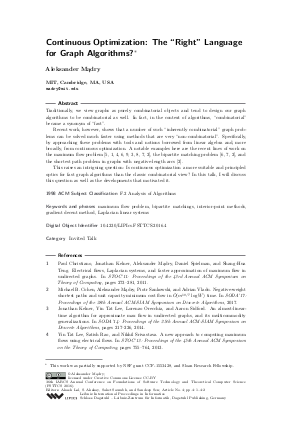Continuous Optimization: The “Right” Language for Graph Algorithms? (Invited Talk)
Author Aleksander Madry
-
Part of:
Volume:
36th IARCS Annual Conference on Foundations of Software Technology and Theoretical Computer Science (FSTTCS 2016)
Part of: Series: Leibniz International Proceedings in Informatics (LIPIcs)
Part of: Conference: IARCS Annual Conference on Foundations of Software Technology and Theoretical Computer Science (FSTTCS) - License:
 Creative Commons Attribution 3.0 Unported license
Creative Commons Attribution 3.0 Unported license
- Publication Date: 2016-12-10
File

PDF
LIPIcs.FSTTCS.2016.4.pdf
- Filesize: 269 kB
- 2 pages
Document Identifiers
Subject Classification
Keywords
- maximum flow problem
- bipartite matchings
- interior-point methods
- gradient decent method
- Laplacian linear systems
Metrics
- Access Statistics
-
Total Accesses (updated on a weekly basis)
0Document
0Metadata
Abstract
Traditionally, we view graphs as purely combinatorial objects and tend to design our graph algorithms to be combinatorial as well. In fact, in the context of algorithms, "combinatorial" became a synonym of "fast". Recent work, however, shows that a number of such "inherently combinatorial" graph problems can be solved much faster using methods that are very "non-combinatorial". Specifically, by approaching these problems with tools and notions borrowed from linear algebra and, more broadly, from continuous optimization. A notable examples here are the recent lines of work on the maximum flow problem, the bipartite matching problem, and the shortest path problem in graphs with negative-length arcs. This raises an intriguing question: Is continuous optimization a more suitable and principled optics for fast graph algorithms than the classic combinatorial view? In this talk, I will discuss this question as well as the developments that motivated it.
Cite As Get BibTex
Aleksander Madry. Continuous Optimization: The “Right” Language for Graph Algorithms? (Invited Talk). In 36th IARCS Annual Conference on Foundations of Software Technology and Theoretical Computer Science (FSTTCS 2016). Leibniz International Proceedings in Informatics (LIPIcs), Volume 65, pp. 4:1-4:2, Schloss Dagstuhl – Leibniz-Zentrum für Informatik (2016)
https://doi.org/10.4230/LIPIcs.FSTTCS.2016.4
BibTex
@InProceedings{madry:LIPIcs.FSTTCS.2016.4,
author = {Madry, Aleksander},
title = {{Continuous Optimization: The “Right” Language for Graph Algorithms?}},
booktitle = {36th IARCS Annual Conference on Foundations of Software Technology and Theoretical Computer Science (FSTTCS 2016)},
pages = {4:1--4:2},
series = {Leibniz International Proceedings in Informatics (LIPIcs)},
ISBN = {978-3-95977-027-9},
ISSN = {1868-8969},
year = {2016},
volume = {65},
editor = {Lal, Akash and Akshay, S. and Saurabh, Saket and Sen, Sandeep},
publisher = {Schloss Dagstuhl -- Leibniz-Zentrum f{\"u}r Informatik},
address = {Dagstuhl, Germany},
URL = {https://drops.dagstuhl.de/entities/document/10.4230/LIPIcs.FSTTCS.2016.4},
URN = {urn:nbn:de:0030-drops-68890},
doi = {10.4230/LIPIcs.FSTTCS.2016.4},
annote = {Keywords: maximum flow problem, bipartite matchings, interior-point methods, gradient decent method, Laplacian linear systems}
}
Author Details
References
-
Paul Christiano, Jonathan Kelner, Aleksander Mądry, Daniel Spielman, and Shang-Hua Teng. Electrical flows, Laplacian systems, and faster approximation of maximum flow in undirected graphs. In STOC'11: Proceedings of the 43rd Annual ACM Symposium on Theory of Computing, pages 273-281, 2011.

-
Michael B. Cohen, Aleksander Mądry, Piotr Sankowski, and Adrian Vladu. Negative-weight shortest paths and unit capacity minimum cost flow in Õ(m^10/7log W) time. In SODA'17: Proceedings of the 28th Annual ACM-SIAM Symposium on Discrete Algorithms, 2017.

-
Jonathan Kelner, Yin Tat Lee, Lorenzo Orecchia, and Aaron Sidford. An almost-linear-time algorithm for approximate max flow in undirected graphs, and its multicommodity generalizations. In SODA'14: Proceedings of the 25th Annual ACM-SIAM Symposium on Discrete Algorithms, pages 217-226, 2014.

-
Yin Tat Lee, Satish Rao, and Nikhil Srivastava. A new approach to computing maximum flows using electrical flows. In STOC'13: Proceedings of the 45th Annual ACM Symposium on the Theory of Computing, pages 755-764, 2013.

-
Aleksander Mądry. Fast approximation algorithms for cut-based problems in undirected graphs. In FOCS'10: Proceedings of the 51st Annual IEEE Symposium on Foundations of Computer Science, pages 245-254, 2010.

-
Aleksander Mądry. Navigating central path with electrical flows: from flows to matchings, and back. In FOCS'13: Proceedings of the 54th Annual IEEE Symposium on Foundations of Computer Science, pages 253-262, 2013.

-
Aleksander Mądry. Computing maximum flow with augmenting electrical flow. In FOCS'16: Proceedings of the 57th Annual IEEE Symposium on Foundations of Computer Science, pages 593-602, 2016.

-
Richard Peng. Approximate undirected maximum flows in O(m polylog(n)) time. In SODA'16: Proceedings of the 27th Annual ACM-SIAM Symposium on Discrete Algorithms, pages 1862-1867, 2016.

-
Jonah Sherman. Nearly maximum flows in nearly linear time. In FOCS'13: Proceedings of the 54th Annual IEEE Symposium on Foundations of Computer Science, pages 263-269, 2013.

